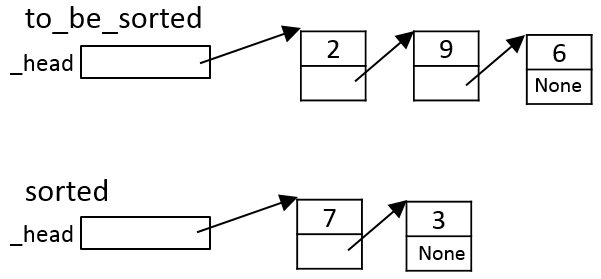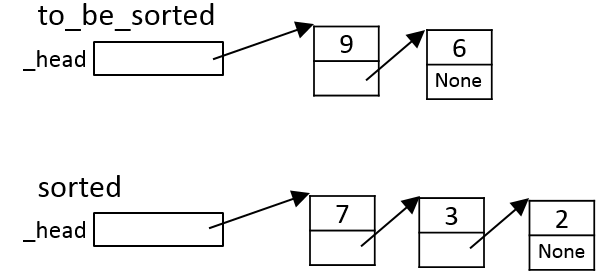

Initially, sorted is empty (i.e., sorted._head has the value None). Each iteration of the algorithm (step 2 below) adds a node to this linked list. The algorithm maintains the invariant that this list is always kept in sorted order.
The iteration stops when all elements have been moved from to_be_sorted to sorted. At that point, to_be_sorted will have the value None and sorted will have all of the nodes in sorted order. The algorithm then copies the list sorted to the head of to_be_sorted.
The key step in the algorithm above is step 2. The logic for this step is as follows. Here, we follow the requirement for this assignment that the list should be sorted in descending order. We say that an element A is "smaller than" an element B if A's _value attribute is less than B's _value attribute.
(One way to do this uses two loops one after another: first, iterate down sorted to find the first node whose count is smaller than curr_element, call this node E1; second, iterate down sorted again to find the node E just before E1.)
Insert curr_element immediately after E.
Iteration 1
The first iteration of the algorithm moves the first element from to_be_sorted for insertion into sorted:

Since sorted is empty (Item a in the algorithm above), curr_element is added to it as its only element:

Note that this preserves the invariant that sorted is in sorted order.
Iteration 2
The algorithm again moves the (current) first element from to_be_sorted:Iteration 3

Since this element is bigger than the first element of sorted (Item b in the algorithm above) it is inserted at the head of sorted:

Note that, again, this preserves the invariant that sorted is in sorted order.
The algorithm once again moves the (current) first element from to_be_sorted:

Since this element is smaller than the first element of sorted (Item c in the algorithm above), the algorithm iterates down sorted to find the position where it should be inserted. In this case, item c.ii of the algorithm applies, with E._next == None; i.e., curr_element is inserted at the end of sorted:

Note that, again, this preserves the invariant that sorted is in sorted order.
This process is repeated with the remaining elements of the linked list to_be_sorted.